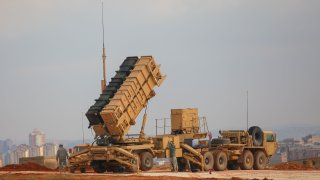U.S. Missile Defense Is Under Strain
Further escalation in the Middle East could severely deplete the U.S. missile arsenal, leaving military assets in Europe and Asia vulnerable.
Following the announcement on October 13 that the U.S. military will deploy a battery of Theater High Altitude Air Defense (THAAD) missiles to Israel, strains and limitations are beginning to show in both countries’ missile defense systems. Although there was no explicit quid pro quo, the deployment may have been linked to pressure on Israel to forego targeting Iranian nuclear and oil industry sites in an effort to limit escalation. The deployment cuts against Israel’s usual emphasis on relying only on its own military for self-defense. This indicates Israeli difficulties with its own missile defense systems, which have had a mixed track record against missiles recently fired by Iran and Hezbollah.
It also reflects American concerns about the number of sea-based Standard (SM-3) anti-ballistic missiles, which have already been expended against incoming threats to Israel and shipping in the Red Sea as a result of attacks by Yemen’s Houthis. If the conflict between Israel and Iran continues and escalates, the United States may soon face a difficult choice about how much to deplete its inventories of THAAD and SM-3 interceptors, given how crucial they would be in other potential conflicts, particularly in Asia.
Israel has a robust, multilayered missile defense system consisting of short-range (Iron Dome), medium-range (David’s Sling), and longer-range (Arrow 2 and 3) interceptors, as well as the U.S.-provided Patriot missile system. When Iran struck on April 13, Israel intercepted almost all of the 170 drones, thirty cruise missiles, and 120 ballistic missiles fired by Iran. But during the October 1 strike from Iran, which included around 180 ballistic missiles, Israel failed to intercept around over thirty, which landed at Nevatim Air Base, and one, which landed near the headquarters of Mossad, Israel’s intelligence agency. This may reflect a decision to conserve interceptor missiles, given that the Nevatim base is hardened against missile strikes and both personnel and aircraft can be protected with adequate warning. Israel does not publish data on its inventory of interceptors, but several former officials quoted by The Financial Times suggested scarcity. The THAAD deployment would augment Israel’s Arrow system at the higher end of the range scale and would be deployed against ballistic missiles from Iran.
The United States, however, could soon face a dilemma about prioritization itself, given that the SM-3 and THAAD are crucial to the U.S. ability to defend bases in the Pacific from China and bases in Europe from Russia. Israeli reports have stated that the deployment responded in part to the fact that the local inventory of SM-3 interceptors in the U.S. Sixth Fleet was nearly depleted after Aegis-equipped destroyers helped Israel defend itself from the October 1 Iranian missile strike.
While the exact number is classified, the overall number of SM-3 interceptors produced is a bit more than 500, with only twelve produced per year. With known testing over the years and recent combat usage, that probably leaves around 400, some of which are deployed onshore in Poland and Romania. This should not be confused with other Standard missile variants, such as the SM-2 and SM-6, which have been produced in larger quantities but are not suited for exoatmospheric missile intercepts.
The THAAD battery deployed to Israel consists of six launchers and a total of forty-eight interceptors. Seven THAAD batteries are currently in use by the U.S. Army. The United Arab Emirates also has THAAD interceptors, which were used successfully for the first time in combat against a missile fired by Yemen’s Houthis in 2022. Lockheed Martin delivered the 800th THAAD interceptor purchased by the U.S. government in December 2023, so given testing usage, the number on hand would be slightly below that.
These are significant inventories of the two ballistic missile interceptor systems, but they are not unlimited. In 2023, Former CENTCOM commander General Frank McKenzie claimed that Iran possessed “over 3,000” ballistic missiles. This is by far the largest ballistic missile inventory in the Middle East. Most of Hezbollah’s arsenal is shorter-range than the SM-3 or THAAD systems would be used to counter. Obviously, not all of these missiles would need to be intercepted by the two American systems. However, the number of Iranian missiles is clearly enough to burn through hundreds of U.S. interceptors in a fully escalated conflict in which the United States came to Israel’s defense.
The potential tradeoffs are painful to contemplate and have received too little public discussion. The United States clearly could not afford to utilize anywhere near half of its interceptor inventory given the acute threats U.S. forces in Asia face from a potential conflict with China. The United States also had minimal capacity to accelerate production of these interceptors in the short run, regardless of our willingness to appropriate money. The tradeoff between defending Israel from Iran or deterring China is not one most of the Washington policy establishment wants to contemplate. Still, it is one that circumstances could rapidly force on us if we fail to contain escalation with Iran.
Greg Priddy is a Senior Fellow for the Middle East at the Center for the National Interest. Follow him on X: @GregPriddy1.
Image: Mehmet Ali Poyraz / Shutterstock.com.

